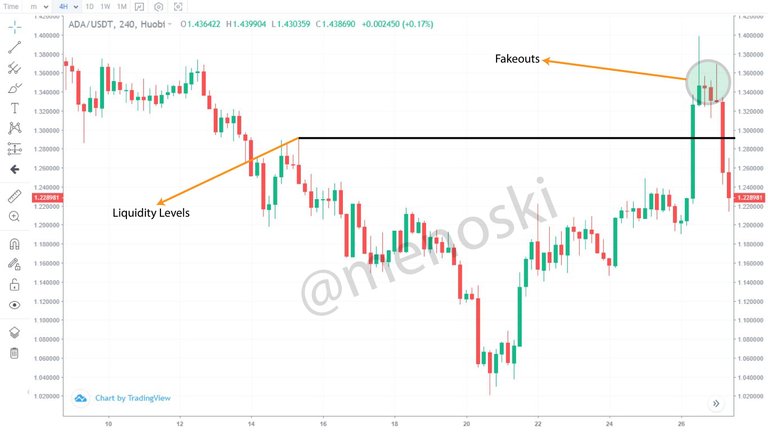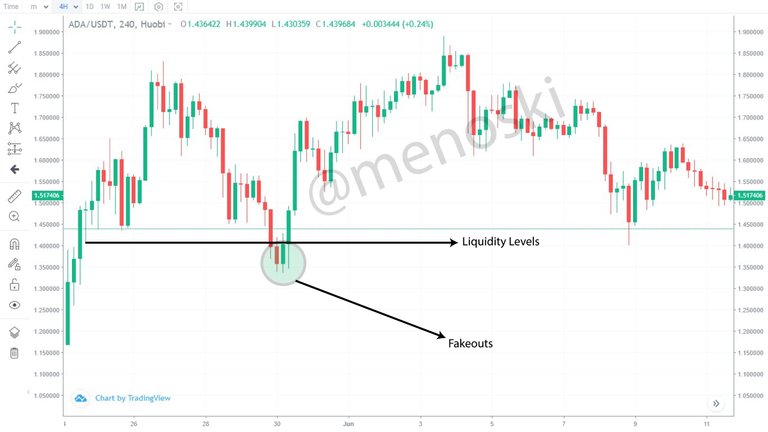Understanding Trading Liquidity Levels The Right Way
Hello everyone, hope you all are doing good? This is the beginning of an exciting three part series, which promises to be informative and also educative, do well to follow all the parts, as you will definitely gain 1 or 2 useful information from the series. In today's article we would be looking at the understanding the concept of Liquidity Levels and reasons why traders get trapped in Fakeouts.

From my understanding of liquidity level, I can say that, Liquidity levels are those significant areas where there are a lot of orders placed, either buy or sell orders, in order to take profit from trades or stop loss.
To understand this concept better, I will try to create a illustration to you. Whenever you are trading an asset, there are resistance points and supports points, right? i.e the highest price point and lowest price point on a trading chart. Lots of take profit orders are placed slightly about resistance point, because traders want to break the resistance and make some more profits, while stop losses are mostly placed just below the support point, in order to safeguard funds. These points are known as liquidity levels.
Liquidity levels are those tiny points of candle sticks that breaks out of both resistance levels and support levels. Let me illustrate this to you visually on BCH/USDT chart below, for better understanding on Liquidity levels.

From the image above, you can clearly see that liquidity levels are the tiny tips of candlesticks that breaks resistance levels and support levels. I hope with the image above, you now understand the concept of Liquidity levels.
Reasons why traders get trapped in Fakeouts
Before I will explain the reasons why traders always get trapped in fakeouts, I will have to explain the concept of Fakeouts, so you can understand why traders get trapped in it.
Fakeouts occurs when the price is expected to move in a particular direction and it does the direct opposite. Fakeouts normally occurs around the liquidity levels. You as a trader, feels the price is about to break either the resistance or the supports levels, and you put in a trade, and boom!!! The price goes the exact opposite direction.
Traders normally get trapped in fakeouts because fakeouts looks like genuine breaks, because they first break the support or resistance levels, which creates some kind of vibe for traders to dig in and make some cool profits and it goes against their price prediction.
That's why the main reason why traders fall victim to fakeouts is because they never wait for trend confirmation. They get anxious as soon as a breakout occurs and don't wait for trend confirmation, and fall victim to fakeouts which are mainly manipulated by institutional investors.

From this ADA/USDT chart above, you can see that, the price broke the resistance liquidity levels and then went the opposite direction. That's a clear example of a resistance liquidity levels Fakeout. Traders thought it was an upward price movement, boom!!! It changed to a downward price movement, thus, retail traders made losses while big whales and institutional investors made profits because they manipulated the market to their favor.

From this ADA/USDT chart above, you can see that, the price broke the support liquidity levels and then went the complete opposite direction. That's a clear example of a support liquidity levels Fakeout. Traders thought it was a downward price movement, boom!!! It changed to an upward price movement, thus, retail traders made losses while big whales and institutional investors made profits because they manipulated the market to their favor.

I hope you all found the article interesting and exciting. Do well to share your thoughts about the article in the comment section below. Thanks.
